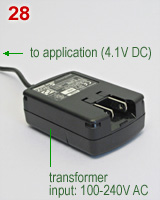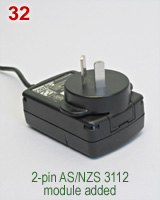 |
IEC 60320 standard Appliance Couplers |
overview |
|
Power cords are
frequently used for appliances that are sold world wide. The same
product can be manufactured for each country, only power
cords with different wall plugs have to be packed. A separate page places IEC
60320 in a historical background. Connector and wall plug are usually moulded to a power cord, but some connectors are available as separate devices that can be rewirered. |
|
|
| Diagrams
of IEC 60320 appliance couplers.
Odd C-numbers refer to connectors; the corresponding equipment inlets are indicated by one number higher. The rated currents are given for 250V. In North America (120V) 10A devices are rated at 15A, and 16A at 20A. 70║ C (='cold'), 120║ C (='hot') and 155║ C (='very hot') indicate the maximum tolerable temperature of the appliance inlet. |
'Hot' and 'very hot' appliance couplers are made of special heat resistance material. Electric kettles are typical examples of 'hot' domestic equipment. Couplers C1-4, C7-12, C17-18 and C23-24 are meant for double insulated electrical appliances that do not require a protective earth connection. X = withdrawn from standard. |
 |
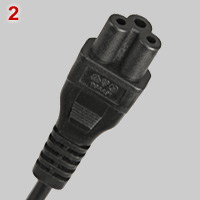 |
 |
 |
 |
 |
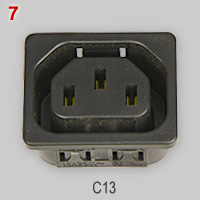 |
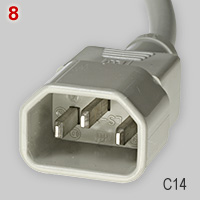 |
| 1 | C1
connector (right) and C2 appliance inlet (left). See Wikipedia
page on IEC 60320 for example uses. |
| 2, 3 |
C5
connector (image no. 2) and C6 inlet (no. 3). Shown connector has been
made by Volex, UK; inlet by Rich Bay, Taiwan. Company logos are shown
at the bottom of the page. |
| 4 | C7
connector and C8 inlet. Like C1-2, also C7-8 couplers are not
polarized. However, polarized C7 and C8 models exists; see inset bottom
left, but they are not a part of the IEC 60320 standard. |
| 5 - 8 |
Group of
commonly used 10A, earthed, appliance couplers. Image
no. 5: C13 appliance cord plug; no. 6: C14 appliance inlet; no. 7: appliance outlet; no. 8: C14 flex cord plug. |
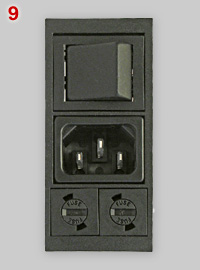 |
 |
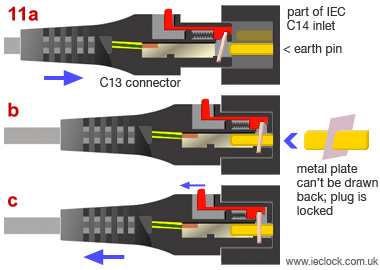 |
 |
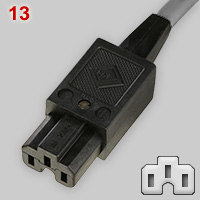 |
 |
| 9 | C14 inlet
with double pole switch and separate fuses for the L and N pole. The
device has been used on hospital equipment. {AH} |
| 10 - 11 |
C13
connector with locking mechanism. Figure 11 shows how it works. The
connector has a metal plate in front of the earth pin contact (11a).
After insertion of the connector, the earth pin of a standard inlet
keeps the plate in a fixed position (11b). The connector is locked.
Manually sliding back the red tab set the plate in a vertical position
and the connector can be removed from the inlet (11c). The drawings are
based on images by the IEC Lock manufacturer. Locks are available for C13
and C19 connectors▀. |
| 12 - 14 |
Special
types of 10A couplers that can withstand temperatures above 70║ C. No.12: C15 connector for temperatures up to 120║ C; no. 13: C15A that can resist 155║ C; no. 14: C16A 155║ C inlet. Connector C15A fits inlets C16A, C16 (not shown) and C14 (70║ C). C15 fits in C16 and C14, but not in a higher temperature inlet (C16A). For the same reason C13 fits in a C14 inlet only. |
 |
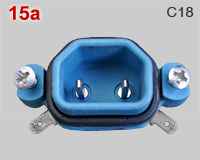 |
15. 15a C17, not earthed 10A connector. Matching C18 inlet. It was part of a Nilfisk vacuum-cleaner, dating back to ca. 1980. Image is based on a photo taken by Jon Krom. C17 / C18 are not commonly used anymore. A C13 plug fits into a C18 inlet (C17 not in C14). |
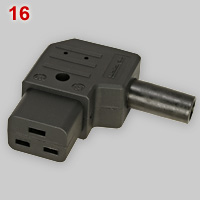 |
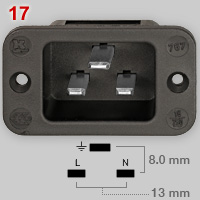 |
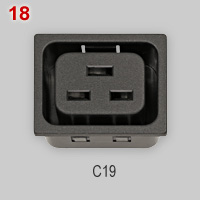 |
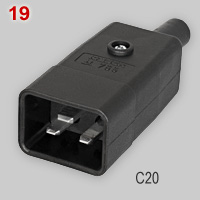 |
 |
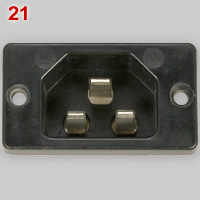 |
 |
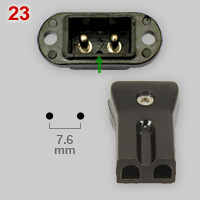 |
| 16 -19 |
Group of
commonly used 16A appliance couplers. Image no. 16: C19 connector; no. 17: C20 inlet; no. 18: C19 appliance outlet; no. 19: C20 plug. Interconnection flex cables have a C20 plug on one side and C19 plug on the other side. |
| 20, 21 |
Special types of 16A couplers that can resist high temperatures. C21 connector (image no. 20) and C22 inlet (image no. 21) withstand temperatures up to 155║ C. |
| 22 | Not
an IEC 60320 connector, but a polarized, not earthed connector designed
by Philips, Netherlands. Rated at 6A-250V. Can be regarded as an
alternative to the not polarized 6A C9 connector. See Dutch plug page for
additional information. |
| 23 | Polarized
not earthed connector and matching inlet. Because of a small projection
(green arrow), the connector can be inserted in one orientation only.
No
indication of rating; probably at most 2A-250V. The origin of this set
of IEC lookalike couplers is not indicated. |
 |
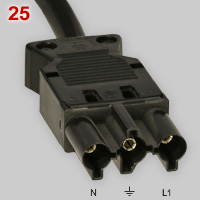 |
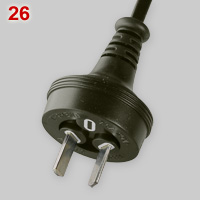 |
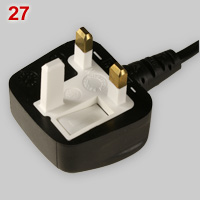 |
|
|
 |
|
|
|
| 24 |
U.S.
hospital-grade C13 connector (no. 24). Although it is not compulsory,
many hospitals prefer that
the plugs and connectors are transparent. It allows visual inspection
of internal connections. {AH} |
| 25 | Earthed
connector, permanently fixed to an appliance cord, rated at 16A - 250V.
Distance between centers of N and L1 contacts is 20 mm. {PM} The German manufacturer, Wieland Electric, is a world leader in pluggable installation technology. Equipment power cords with Wieland connectors are rather uncommon. Other examples of Wieland outlets and plugs are shown elsewhere. |
| 26 | Australasian
10A-250V, 2 pin
plug
for appliances that do not need an earth connection. Standard AS/NZ3112
plugs have three pins, but for appliance cords with a not earthed
connector (C1, C7, C17 or
C23) the use of a moulded wall plug
without earth pin is permitted. |
| 27 | BS 1363 plug moulded to a appliance cord for not earthed equipment. An earth pin is still essential to open the safety shutters of a BS 1363 socket. Instead of a metal pin, that may suggest earthing, a plastic replacement pin is used. This pin is known as a ISOD = Insulated Shutter Opening Device. An ISOD ensures also that the plug remains polarized. |
| 28-32 | Devices with separate, add-on plug modules are frequently used for chargers. It is an alternative to providing a charger with several, country specific appliance cords. The charger shown was used for a 2002 model Palm PDA. |
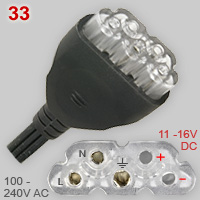 |
| 33 | Appliance connector plug used for a Dell
laptop charger that could be powered by both 100 - 240 Volt AC, and 11
- 16 Volt DC. The charger has one trapezoidal inlet with 5 contacts. Two appliance cords are supplied, one with an earthed 120V or 230V wall plug, the other with a 12V car plug. The image shows the 100-240V model. The two (empty) slots right are used on the 11-16V model. Most other laptop computers use two different chargers. {PM} |
 |
 |
 |
 |
 |
 |
 |
 |
| Chin Chen, Taiwan [no. 24] |
Desco-Werk, Germany [no. 4] |
Felmas, Germany [no. 4] |
IEC Lock, UK [no. 10] |
I-Sheng, Taiwan [nos. 8, 26] |
Unknown (UK?) company [no. 5] |
Martin Kaiser, Germany [nos. 12, 14-17 |
Kautt & Bux, Germany [no. 13] |
 |
 |
 |
19-21] | ||||
| Rich Bay, Taiwan [nos. 3, 18] |
Volex, UK [nos. 2, 27] |
Wieland
Electric Germany [no. 25] |
|
|
|
|
|
|

